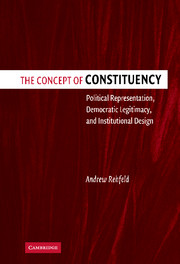 The Concept of Constituency
The Concept of Constituency Published online by Cambridge University Press: 27 July 2009
The second section of the Estates encompasses the changing element in civil society, which can play its part only by means of deputies; the external reason for this is the sheer number of its members, but the essential reason lies in the nature of its determination and activity. In so far as these deputies are elected by civil society, it is immediately evident that, in electing them, society acts as what it is. That is, it is not split up into individual atomic units which are merely assembled for a moment to perform a single temporary act and have no further cohesion; on the contrary, it is articulated into its associations, communities and corporations which, although they are already in being, acquire in this way a political connotation.
G. W. F. HegelImagine that Alex, a French citizen, came to observe an election in the United States. Upon her return home, she wrote the following description of what she saw:
Democracy in America is a system in which its adult members step into booths or other private rooms to register their opinions of who should lead them. This is the meaning of democracy: Individuals can punch chads, pull levers, and darken ovals to select their leadership.
Alex is not exactly mistaken, but she has missed the point. Voting is not the meaning of democracy, it is its central mechanism.
To save this book to your Kindle, first ensure no-reply@cambridge.org is added to your Approved Personal Document E-mail List under your Personal Document Settings on the Manage Your Content and Devices page of your Amazon account. Then enter the ‘name’ part of your Kindle email address below. Find out more about saving to your Kindle.
Note you can select to save to either the @free.kindle.com or @kindle.com variations. ‘@free.kindle.com’ emails are free but can only be saved to your device when it is connected to wi-fi. ‘@kindle.com’ emails can be delivered even when you are not connected to wi-fi, but note that service fees apply.
Find out more about the Kindle Personal Document Service.
To save content items to your account, please confirm that you agree to abide by our usage policies. If this is the first time you use this feature, you will be asked to authorise Cambridge Core to connect with your account. Find out more about saving content to Dropbox.
To save content items to your account, please confirm that you agree to abide by our usage policies. If this is the first time you use this feature, you will be asked to authorise Cambridge Core to connect with your account. Find out more about saving content to Google Drive.